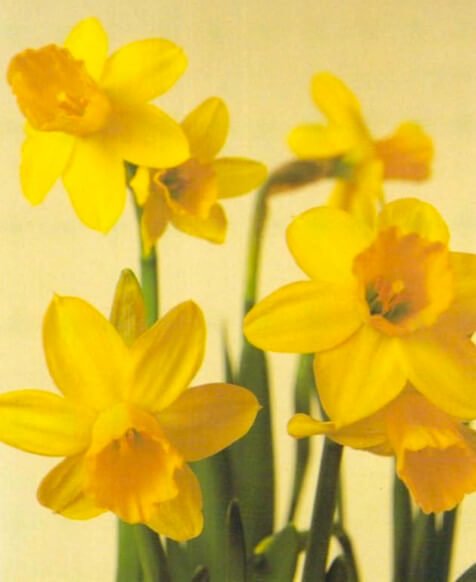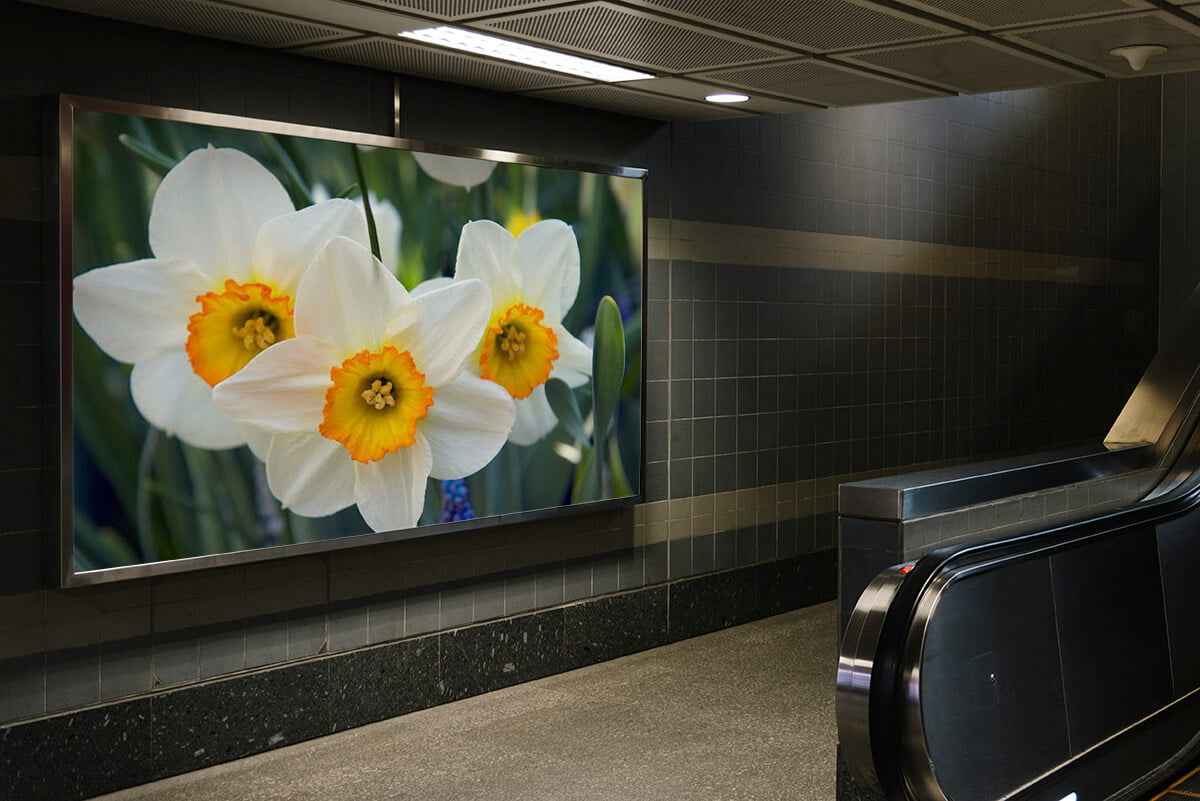[Ebook Việt Hoá] The Instant Guide to Healthy Houseplants (Hướng dẫn tức thời để chăm cây trong nhà khoẻ mạnh), Chi Narcissus - Chi Thuỷ Tiên
[Ebook Việt Hoá] The Instant Guide to Healthy Houseplants: Narcissus (Daffodil)
- Nguồn: [Ebook Việt Hoá] The Instant Guide to Healthy Houseplants (Hướng dẫn tức thời để chăm cây trong nhà khoẻ mạnh)
- Biên tập: Dũng Cá Xinh
- Biên dịch: Team Codai.net
English
The Narcissus family, a vast and beautiful one, contains hundreds of varieties. All grow from bulbs, which produce narrow, straplike leaves and flowers; and the latter’s petals are grouped around a central cup, or trumpet. These plants are classified according to trumpet and petal lengths, generally being called daffodils when the trumpet is at least as long as the petal. For growing in pots or bowls, choose one of the smaller varieties or buy bulbs specially prepared for indoor flowering. Bulbs, which may be single or double nosed, should be potted in early autumn with the nose just above the soil. They need at least 8 weeks in a dark, cold place for their shoots to appear, after which they should be brought into a cool, light room.

Light
Complete darkness is needed for 8 weeks, then diffused light until shoots are green and growing well, and finally full light for flowering.
Temperature
Maximum while in darkness (until bud has cleared the bulb), 40-45°F (4-7°C); maximum for flowering, 60°F (16°C).
Water
Soak soil after planting, then do not water until brought into light. Thereafter, water 2-3 times per week to keep soil moist at all times.
Humidity
Provide good ventilation.
Feeding
If bulbs are to be reused, feed weekly with diluted liquid houseplant food at manufacturer’s recommended strength, beginning when growth is 3 inches (8 cm) high.
Soil
Use loam-based soil mixed with a handful of fine grit.
After flowering
If bulbs are to be reused, cut back dead flower stems. Allow leaves to die (at least 8 weeks), then cut back to soil level. Lift bulb, separate offsets and store bulb in a cool, dry place. Repot in autumn. If desired, plant outdoors before the leaves die down.

What Goes Wrong

- Flower bud becomes pale brown and stops growing: Too dry while developing. Keep moist at all times. Plant will not flower, but continue feeding until foliage dies. as bulb can be saved for repotting.
- Lush leaves but no flowers: Overfeeding. Begin feeding with diluted liquid houseplant food at weekly intervals when growth is 3 inches (8 cm) high. Bud remains near neck of bulb: Pot brought into full light and heat too early. Shoots should be growing strongly and bud clear of neck before pot is moved. If plants have been placed outdoors, suspect slugs or snails. Sprinkle with slug pellets if slime trails are present.
- Tips of leaves shrivel, brown spots appear on flowers: Fungal disease. Spray with bordeaux mixture. Plant will not recover if disease is severe.
- Flowers shrivel, leaves are blotched: Too hot. air too dry. Move to a cooler place. Spray with clean water if temperature near 60°F.
- Leaves yellow and soft. Bulb is soft when lifted: Basal rot caused by being too wet. Ensure good drainage in bowl by putting a layer of gravel .n bottom of bowl before planting. Rotted plants will not bloom.
- Bulbs produce thin, grass-like leaves and no flowers: Bulb may have been attacked by grubs of narcissi fly in previous season or may not have been fed. Choose firm, heavy bulbs for planting.
- Long yellow stripes on leaves: Viral disease. Plants should flower, but discard bulbs after-wards and do not take offsets for planting. Do not reuse soil.
- Leaves and stem are pale and elongated, leaves may be drooping or lying flat: Much too dark or too hot. Daffodils need good light but not direct sunlight; maximum temperature for good flowers is 60°F (16°C). Stake before buds are fully developed; more importantly, provide cool. light situation.
- Light brown spots on flowers. Reddish patches on leaves: Botrytis. Cut off affected leaves. Spray with bordeaux mixture.
Tiếng Việt
Họ Thủy tiên, rất rộng lớn và đẹp, có hàng trăm loại. Tất cả đều được mọc lên từ củ, nó sẽ cho ra lá nhọn có hình như dây đai và hoa; và sau đó hoa sẽ mọc xung quanh đài hoa hoặc phần có hình như kèn. Những cây này được phân loại theo chiều dài của kèn và cánh hoa, thường được gọi là hoa thủy tiên vàng khi kèn dài ít nhất bằng cánh hoa. Để trồng trong chậu hoặc bát, hãy chọn một trong những giống nhỏ hơn hoặc mua những củ được chuẩn bị đặc biệt để ra hoa trong nhà. Củ, có thể là mũi đơn hoặc kép, nên được trồng trong chậu vào đầu mùa thu với mũi ngay trên đất. Chúng cần ít nhất 8 tuần ở nơi tối và lạnh để chồi xuất hiện, sau đó nên được đưa vào phòng mát mẻ và có ánh sáng.

Ánh sáng
Cần bóng tối hoàn toàn trong 8 tuần, sau đó là ánh sáng khuếch tán cho đến khi chồi xanh và phát triển tốt và cuối cùng là ánh sáng đầy đủ để ra hoa.
Nhiệt độ
Tối đa khi ở trong bóng tối (đến khi chồi đã mọc rõ trên củ) là 40-45 ° F (4-7 ° C); tối đa cho khi cây ra hoa là 60 ° F (16 ° C).
Nước
Ngâm đất sau khi trồng, không tưới nước cho đến khi đem ra ánh sáng. Sau đó, tưới 2-3 lần mỗi tuần để giữ cho đất luôn ẩm.
Độ ẩm
Cung cấp hệ thống thông gió tốt.
Bón phân
Nếu muốn tái sử dụng củ, hãy bón phân hàng tuần với phân bón hữu cơ dạng lỏng pha loãng theo khuyến cáo của nhà sản xuất, bắt đầu khi cây phát triển cao 3 inch (8 cm).
Đất
Sử dụng đất mùn trộn với một ít sạn mịn.
Sau khi ra hoa
Nếu muốn sử dụng lại củ, hãy cắt bỏ những cành hoa đã chết. Để lá chết (ít nhất 8 tuần), sau đó cắt trở lại mặt đất. Nhấc củ, tách các phần bù ra và bảo quản củ ở nơi khô ráo, thoáng mát. Thay chậu vào mùa thu. Nếu muốn, hãy trồng ngoài trời trước khi lá héo.

Những vấn đề có thể xảy ra

- Nụ hoa chuyển sang màu nâu nhạt và ngừng phát triển: Quá khô. Giữ ẩm mọi lúc. Cây sẽ không ra hoa, nhưng vẫn tiếp tục bón phân cho đến khi tàn lá. Vì có thể tiết kiệm được củ để thay chậu.
- Lá tươi tốt nhưng không có hoa: Bón phân quá nhiều. Bắt đầu bón phân hữu cơ dạng lỏng pha loãng vào khoảng thời gian hàng tuần khi tăng trưởng cao 3 inch (8 cm).
- Chồi thừa gần cổ của củ: Chậu đem ra ánh sáng đầy đủ quá sớm. Chồi phải phát triển mạnh và chồi khỏi củ trước khi chuyển chậu. Nếu cây đã được đặt ngoài trời, nghi ngờ có sên hoặc ốc sên. Rắc viên đặc trị sên nếu xuất hiện các vệt chất nhờn.
- Đầu lá nhăn lại, trên hoa xuất hiện đốm nâu: Bệnh nấm. Xịt hỗn hợp màu bordeaux. Cây sẽ không phục hồi nếu bệnh nặng.
- Hoa héo, lá úa: Quá nóng, không khí quá khô. Di chuyển đến một nơi mát mẻ hơn. Xịt bằng nước sạch nếu nhiệt độ gần 60 ° F.
- Lá màu vàng và mềm. Củ bị mềm khi nhấc lên: Thân củ bị thối do quá ướt. Đảm bảo thoát nước tốt trong chậu bằng cách rải một lớp sỏi dưới đáy bát trước khi trồng. Cây bị thối rữa sẽ không nở hoa.
- Củ ra lá mỏng như cỏ và không có hoa: Củ có thể đã bị ruồi giả ong tấn công trong mùa trước hoặc có thể chưa được bón phân. Chọn những củ chắc, nặng để trồng.
- Các sọc vàng dài trên lá: Bệnh do virus. Cây sẽ ra hoa, nhưng sau đó hãy loại bỏ củ và không ngắt củ để trồng. Không tái sử dụng đất.
- Lá và thân nhợt nhạt, thuôn dài, lá có thể rũ xuống hoặc nằm phẳng: Quá tối hoặc quá nóng. Hoa cần ánh sáng tốt nhưng không phải ánh nắng trực tiếp; nhiệt độ tối đa cho hoa tươi tốt là 60 ° F (16 ° C). Cắm cọc trước khi chồi phát triển đầy đủ; quan trọng hơn cả là đặt cây vào vị trí sáng và mát mẻ.
- Đốm nâu nhạt trên hoa, đốm đỏ trên lá: Nấm mốc. Cắt bỏ các lá bị ảnh hưởng. Xịt hỗn hợp màu bordeaux.



